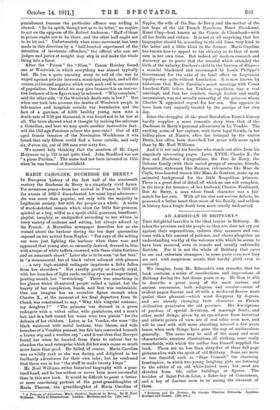MARIE CAROLINE, DUCHESSE DE BERRY.* IN European history of the
first half of the nineteenth century the Duchesse de Berry is a singularly vivid figure. For seventeen years—from her arrival in France in 1816 till the events of 1832-3 disenchanted her most loyal admirers— she was more than popular, not only with the majority in Legitimist society, but with the people as a whole. A series of word-sketches remain which show the little fair princess, spirited as a boy, wilful as a spoilt child, generous, beneficent, playful, haughty, or undignified according to her whims, in svery variety of costume and setting, but always adored by the French. A Marseilles newspaper describes her as she 'raised about the harbour during the ten days' quarantine imposed on her arrival from Naples : "The rays of the setting sun were just lighting the harbour when there rose and appeared that young star, so earnestly desired, dressed in blue with a toque of white taffeta crowned with three white feathers and an amaranth shawl." Later she is to be seen "at her best" in "a monumental hat of black velvet adorned with plumes . . . a very high-waisted redingote imprisons a fichu fallen from her shoulders." Not exactly pretty or exactly royal, with her bunches of light curls, smiling eyes, and impertinent, pouting mouth, but "bewitching." There was something in her glance which ill-natured people called a squint, but the beauty of her complexion, hands, and feet was undeniable. One can imagine her an eccentric figure enough when Charles X., at the moment of his final departure from St. Cloud, was constrained to say, "Why this singular costume, my daughter ? " "The princess was dressed in a green redingote with a velvet collar, wide pantaloons, and a man's hat, and in a belt round her waist were two pistols" for the defence of her children. Later, in La Vendee, she wore "the black waistcoat with metal buttons, blue blouse, and wide breeches of a Vendeen peasant, her fair hair concealed beneath a brown wig and a woollen cap"; and it was thus that Berryer found her when he hurried from Paris to entreat her to abandon the mad enterprise which did her son's cause so much more harm than good. He failed, of course. Marie Caroline was as wildly rash as she was daring, and delighted in her foolhardy adventures for their own sake; but he confessed that there was in her "the stuff to make twenty kings."
Mr. Noel Williams writes historical biography with a prac- tised hand, and he has seldom or never been more successful than in this new book. It would be difficult to paint a better or more convincing portrait of the great-granddaughter of Maria Theresa, the granddaughter of Maria Carolina of
• A Princess of Adventure: Marie Caroline, Duchene de Berry. By H. Noel Williams. With 17 Illustrations. London : Methuen and Co. [15e. net.] Naples, the wife of the Due de Berry and the mother of the last hope of the old French Bourbons, Henri Dieudonne, Henri Cinq—best known as the Comte de Chambord—with all her faults and virtues. It is not at all surprising that her biographer should be, according to the old lines, very kind to the latter and a little blind to the former. Marie Caroline has known how to appeal to his chivalry as to that of most men in her own time. But indeed all modern research and discovery go to prove that the scandal which attended-the birth of the unlucky Duchess's child in the fortress of Blaye- a scandal blackened and encouraged by Louis Philippe's Government for the sake of its fatal effect on Legitimist loyalty—was quite without foundation. It is now known by historians that Marie Caroline's secret marriage with Count Lucchesi-Palli before her Vendeen expedition was a real marriage, and that her conduct, though foolish and madly inconsistent, was not morally unworthy of the princess whom Charles X. appointed regent for her son. She appears to have been very unjustly treated by the gossips of her own day.
Since the struggles of the great Revolution French history hardly supplies a more romantic story than that of the Duchesse de Berry's personal adventures in La Vendee. The exciting scene of her capture, with three loyal friends, in her hiding-place at Nantes, after her betrayal by the traitor Deutz, has often been described, but never with more spirit than by Mr. Noel Williams.
And it is not only his heroine who stands out alive from his singularly interesting pages. Louis XVIIL, Charles X., the Due and Duchesse d'Angouleme, the Due de Berry, the Orleans family (with their varied groups of enemies, friends, favourites), statesmen like Decazes, intrigantes like Mme. du Cayla, true-hearted women like Mme. de Gontaut, make up an animated background for the little Neapolitan princess. There is a great deal of detail, of which no one will complain, in the story, for instance, of her husband, Charles Ferdinand, Due de Berry, a man whose frank character was a fair match for her own. With all his sins and serious defects, he possessed a better heart than most of his family, and seldom in history has a tragic death been more cruelly undeserved.


















































 Previous page
Previous page